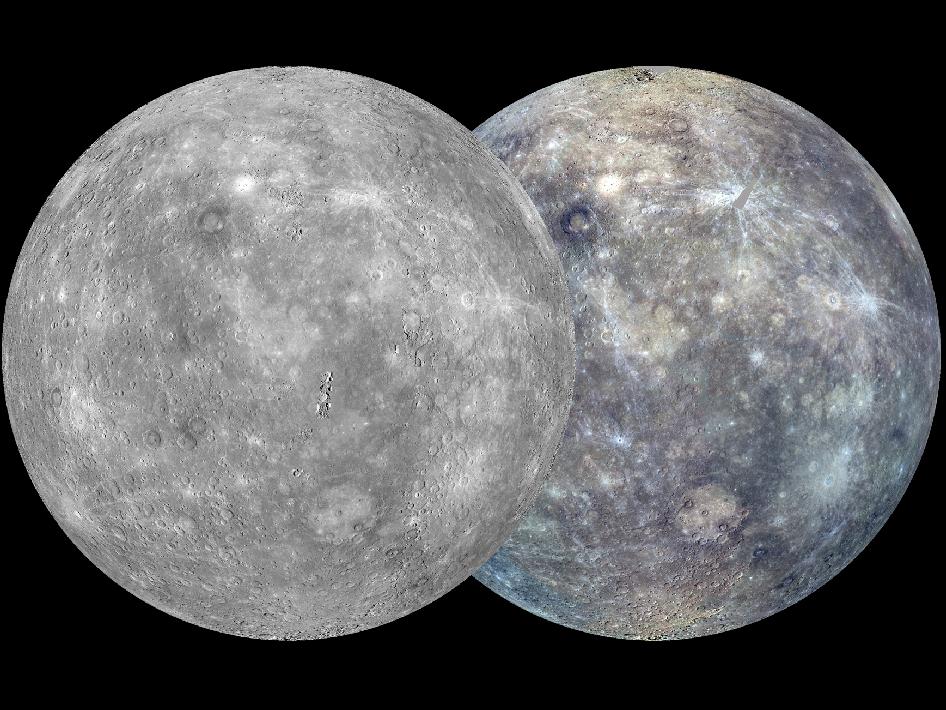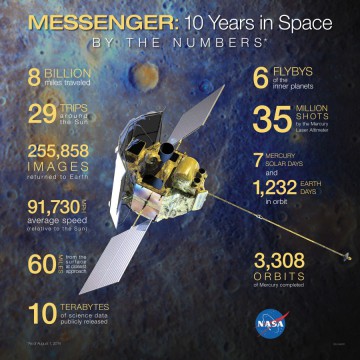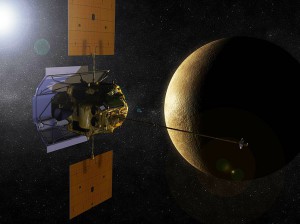
One of the most oft-repeated quotes in the English lexicon is: “There’s no place like home.” One spacecraft’s long journey, begun in 2004, will end as it impacts upon the surface of its celestial “home” later this month. In a press conference held this afternoon (Thursday, April 16), MErcury Surface, Space ENvironment, GEochemistry, and Ranging (MESSENGER) engineers and project managers revealed that the spacecraft is expected to impact upon Mercury, our Solar System’s closest planet to the Sun, on Thursday, April 30. NASA’s MESSENGER was originally intended to have a service life of just one Earth year. However, fuel economy extended the mission for three more years and then some, with a final orbital correction scheduled for April 24. In addition, the press conference participants recalled MESSENGER’s top scientific findings and technological achievements.
Launched Aug. 3, 2004, aboard a Delta II 7925 rocket from Cape Canaveral Air Force Station’s SLC-17B, MESSENGER traveled for more than 6.5 years before it was inserted into Mercury’s orbit. The planet closest to the Sun had only been previously investigated by NASA’s Mariner 10 spacecraft in the mid-1970s during three flybys; it was then discovered that the planet’s environment of “extremes” posed a challenge to future spacecraft. Indeed, no spacecraft would visit Mercury for nearly 30 more years.
AmericaSpace’s Leonidas Papadopoulos discussed that spacecraft’s findings in a previous article. He wrote: “The results of the Mariner 10 mission had shown that Mercury is the planet of the extremes. Despite being the smallest of the terrestrial planets, with a diameter approximately one-third that of Earth, it is nevertheless one of the most massive, with a density of approximately 5.427 g per cubic centimeter—only slightly less than that of our Home Planet. Furthermore, Mercury exhibits the greatest temperature range of all the planets in the Solar System: When it is at its closest distance to the Sun, its day side bakes at a scorchingly hot 430°C, while at the same time the temperatures on its night side can plummet as low as -180°C. Furthermore, Mercury’s surface topography, which greatly resembles that of the Earth’s Moon, as was revealed to the spacecraft’s cameras, hinted at a dead world whose geologic activity had for the most part ceased long ago. Nevertheless, due to its specific trajectory, Mariner 10 was able to image only half of the planet’s surface while offering only tantalizing clues as to its fascinating nature and underscoring the need for a more thorough, in-depth study from a follow-up mission.”

Enter MESSENGER, which, according to NASA, “required six planetary flybys, six propulsive maneuvers, [and] 600 kg of propellant” prior to reaching its destination on March 18, 2011.
MESSENGER Principal Investigator Sean Solomon detailed what the spacecraft had to endure during its mission to one of the most hostile, unknown environments in our Solar System: “MESSENGER had to survive heating from the Sun, heating from the dayside of Mercury, and the harsh radiation environment in the inner heliosphere, and the clearest demonstration that our innovative engineers were up to the task has been the spacecraft’s longevity in one of the toughest neighborhoods in our Solar System. Moreover, all of the instruments that we selected nearly two decades ago have proven their worth and have yielded an amazing series of discoveries about the innermost planet.”
To date, the spacecraft is the only one to explore Mercury in detail and has provided scientists with an unprecedented, stunning view of the mysterious planet. Solomon underscored how much of an enigma Mercury was prior to setting out upon the mission: “Although Mercury is one of Earth’s nearest planetary neighbors, astonishingly little was known when we set out. MESSENGER has at last brought Mercury up to the level of understanding of its sister planets in the inner Solar System. Of course, the more we learn, the more new questions we can ask, and there are ample reasons to return to Mercury with new missions.”
Solomon discussed one of MESSENGER’s biggest findings during its four years of service, which involves evidence of ice water and other materials at Mercury’s polar regions. In addition, he emphasized how this discovery will inspire future Mercury missions: “The water now stored in ice deposits in the permanently shadowed floors of impact craters at Mercury’s poles most likely was delivered to the innermost planet by the impacts of comets and volatile-rich asteroids. Those same impacts also likely delivered the material in the dark layer discovered by MESSENGER to cover most polar deposits and interpreted, on the basis of its sublimation temperature and low reflectance, to be carbonaceous. By this interpretation, Mercury’s polar regions serve as a witness plate to the delivery to the inner solar system of water and organic compounds from the outer solar system, a process that much earlier may have led to prebiotic chemical synthesis and the origin of life on Earth. MESSENGER’s findings have made Mercury an even more interesting body for future exploration than before our mission.”

In addition to its momentous scientific findings, MESSENGER also represented a technological breakthrough in spacecraft design, as it survived a harsh environment for a period much longer than its original lifetime. It employed an innovative ceramic cloth sunshade, designed to protect sensitive spacecraft instruments from extreme temperature excursions. In addition, its orientation was fine-tuned to balance heating conditions. A list of 10 major spacecraft innovations, along with a detailed list of MESSENGER’s scientific findings, can be accessed through the project’s website.
As MESSENGER’s mission draws to a close, a new Mercury mission is under development. A joint mission to Mercury to be conducted by the European Space Agency (ESA) and the Japan Aerospace Exploration Agency (JAXA), BepiColombo, is scheduled to launch in January 2017. Consisting of two separate orbiters, ESA stated, “Once the orbiters are deployed in their separate orbits around the innermost planet, they will carry out the most comprehensive exploration of Mercury and its environment ever undertaken.” MESSENGER’s journey might be at its end, but the study of Mercury has only just begun.
Want to keep up-to-date with all things space? Be sure to “Like” AmericaSpace on Facebook and follow us on Twitter: @AmericaSpace




As we “touch” Mercury for the very first time, one hopes that we can send landers to the surface, especially in the regions where evidence of water may be found.
Thank you, Messenger!